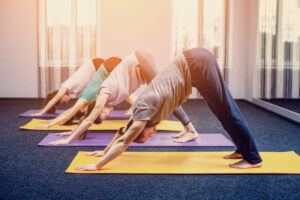Exercise for glaucoma patients
Posted in Bellingham, Eye Blog, Medical, Mount Vernon, Sedro-Woolley, Stanwood, Whidbey

When Dr. Ernesto Golez III, our glaucoma specialist, talks to patients with a first-time diagnosis of glaucoma or high eye pressure, he recommends caution with certain types of exercise–for example, anything that causes blood to rush to the head. Some positions and maneuvers may cause eye pressure to spike–or even, with regular use, cause the glaucoma to progress even with treatment. But other kinds of exercise have very little risk attached to them.
An article published in the American Academy of Ophthalmology (AAO) in 2019 talked about different types of exercise and the levels of risk associated with them, but also cautioned that in some studies–as with certain weightlifting maneuvers–the results have been inconclusive. So what should you do if you have high pressure inside your eyes? Exercise is still good for you–and good for helping to slow the progression of glaucoma!
Why is some exercise risky with glaucoma?
Glaucoma is a disease where pressure builds inside the eye, usually caused by fluid not draining properly. You can learn more details about the different types of glaucoma here. Increased eye pressure can damage the optic nerve, permanently damaging your sight. Glaucoma treatment is all about doing everything possible to reduce the amount of pressure in the eye, whether through medication, surgery, or both. But, as shown in the previously mentioned article by AAO, there is good reason to believe that positions that invert your head below your heart, especially headstands, can actually double your eye pressure–and with sustained use can cause glaucoma to progress despite treatments.
Do’s and Don’ts
DO:

- Exercise! Any kind of aerobic exercise is good for your heart and blood flow, which in turn is great for glaucoma patients. In fact, if you aren’t already exercising, starting to exercise actually has a greater chance of helping to lower your eye pressure after diagnosis.
- Weight training–to a certain degree. Low-level weight routines are fine, and patients with mild cases of glaucoma may be able to do their regular weight training routines. In all cases, continuing to breathe/exhale while lifting is very important.
- Yoga, pilates, and stretching–but eliminating certain positions (see below).
AVOID:
- Headstands of any kind. Sorry, gymnasts! Headstands are the worst offenders for increasing pressure in the eye.
- Lifting VERY heavy weights. 200+ pounds, or the kind of lifting that causes a lot of strain, may be risky, although studies on weight training have been inconclusive overall.
- Other kinds of inversions. Downward dog, one of the popular Yoga positions, for example. If you do yoga, work with an instructor to modify inverted poses.
General advice: if it’s going to cause large amounts of strain–the kind of strenuous exercise that makes you go red in the face–use common sense. Avoid anything that restricts breathing or forces you to hold your breath. Breathing hard is probably fine, as long as you keep breathing without restriction! And when in doubt, you should always call and ask your eye doctor for advice.
Contact Cascadia Eye
If you would like to learn more, or if you would like to schedule an appointment or consultation with our talented doctors at Cascadia Eye, please contact us today. You may also pre-shop for glasses at our online pre-shopping page any time. Our entire team is committed to protecting and improving your vision and the health of your eyes. We are happy to answer any questions you might have!
In addition, join us on Facebook, Instagram or YouTube to ask your questions about eyes, exams, and our practice. We’d love to hear from you – and there might be a blog to address your questions in the future.


